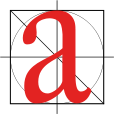- Leading
-
"Leads" redirects here. For the city and metropolitan borough in West Yorkshire, England, see Leeds. For other uses, see Lead (disambiguation)."Line leading" and "Line lead" redirect here. For the water navigation concept, see Leading line. For other uses, see Lead line (disambiguation)."Double spacing" redirects here. For the practice of putting two spaces after the end of a sentence, see Sentence spacing.
 Text set solid vs. text set with added leading
Text set solid vs. text set with added leading
In typography, leading (
 /ˈlɛdɪŋ/) refers to the distance between the baselines of successive lines of type. The term originated in the days of hand-typesetting, when thin strips of lead were inserted into the formes to increase the vertical distance between lines of type. The term is still used in modern page layout software such as QuarkXPress and Adobe InDesign
/ˈlɛdɪŋ/) refers to the distance between the baselines of successive lines of type. The term originated in the days of hand-typesetting, when thin strips of lead were inserted into the formes to increase the vertical distance between lines of type. The term is still used in modern page layout software such as QuarkXPress and Adobe InDesignIn consumer-oriented word processing software, this concept is usually referred to as "line spacing" or "interline spacing."
Contents
Origins
The word comes from lead strips that were put between set lines. When type was set by hand in printing presses, slugs or strips of lead (reglets) of appropriate thicknesses were inserted between lines of type to add vertical space, to fill available space on the page.
Text set "solid" (no leading) appears cramped, with ascenders almost touching descenders from the previous line. The lack of white space between lines makes it difficult for the eye to track from one line to the next, and hampers readability.
The following block of text has no leading:
Typography (Greek: typos "form", graphein "to write") is the art and technique of setting written subject matter in type using a combination of typeface styles, point sizes, line lengths, line leading, character spacing, and word spacing to produce typeset artwork in physical or digital form.
This block of text set with 50% leading is easier to read:
Typography (Greek: typos "form", graphein "to write") is the art and technique of setting written subject matter in type using a combination of typeface styles, point sizes, line lengths, line leading, character spacing, and word spacing to produce typeset artwork in physical or digital form.
This block of text at 100% leading is harder to read and makes less efficient use of vertical page space:
Typography (Greek: typos "form", graphein "to write") is the art and technique of setting written subject matter in type using a combination of typeface styles, point sizes, line lengths, line leading, character spacing, and word spacing to produce typeset artwork in physical or digital form.
In CSS, leading is implemented by creating a difference between the content height and the value of the
line-heightproperty. Half the leading is called the half-leading. User agents center glyphs vertically in an inline box, which adds half-leading on the top and bottom. For example, if a piece of text is '12px' high and the line-height value is '14px', 2pxs of extra space should be added: 1px above and 1px below the letters. (This applies to empty boxes as well, as if the empty box contained an infinitely narrow letter.)Feathering
The leading may be increased to align the bottom line of text on a page in a process known as feathering,[1] carding, or vertical justification.
See also
- Interline spacing
References
- ^ Glossary of Typesetting Terms, R. Eckersley et al., University Of Chicago Press, 1995
Typography terminology Page 
Paragraph Character Typeface anatomyCounter · Diacritics · Dingbat · Glyph · Initial · Kerning · Letter-spacing · Ligature · Subscript and superscript · Swash · Text figuresCapitalizationVertical aspectsClassifications Punctuation Typesetting Calligraphy · ETAOIN SHRDLU · Font (Computer font) · Font catalog · Letterpress · Lorem ipsum · Movable type · Pangram · Phototypesetting · Punchcutting · Type design · Typeface · Type foundry · MicrotypographyTypographic units Digital typography Categories:- Typography
- Whitespace
Wikimedia Foundation. 2010.
